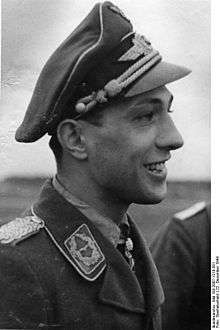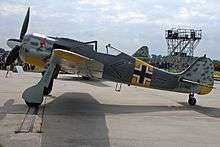Erich Rudorffer
| Erich Rudorffer | |
|---|---|
 Erich Rudorffer in 1944 | |
| Nickname(s) | Fighter of Libau |
| Born |
1 November 1917 Zwochau, Saxony, German Empire |
| Died | 8 April 2016 (aged 98) |
| Allegiance |
|
| Service/branch |
|
| Years of service | 1936–45 |
| Rank | Major |
| Unit | JG 2, JG 7 and JG 54 |
| Commands held | 6./JG 2, II./JG 2, I./JG 7 and II./JG 54 |
| Battles/wars | |
| Awards | Knight's Cross of the Iron Cross with Oak Leaves and Swords |
Erich Rudorffer (1 November 1917 – 8 April 2016) was a German Luftwaffe fighter ace who was one of a handful who served with the Luftwaffe through the whole of World War II. He was the 7th most successful fighter pilot in the history of air warfare, with 222 victories claimed. Rudorffer fought in all the major German theaters of war, including the European and Mediterranean Theater of Operations and the Eastern Front. During the war he flew more than 1000 combat missions, engaging in aerial combat over 300 times. Rudorffer was shot down by flak and enemy fighters 16 times and had to take to his parachute nine times. He distinguished himself by shooting down 13 enemy planes in 17 minutes. His 222 aerial victories included 58 heavily armoured Il-2 Sturmovik ground attack aircraft.
Early life
Rudorffer was born on 1 November 1917 in Zwochau, at the time in the Kingdom of Saxony of the German Empire. After graduation from school, he received a vocational education as an automobile metalsmith specialized in coachbuilding. He joined the military service of the Luftwaffe with Flieger-Ersatz-Abteilung 61 (Flier Replacement Unit 61) in Oschatz on 16 April 1936. From 2 September to 15 October 1936, he served with Kampfgeschwader 253 (KG 253—253rd Bomber Wing) and from 16 October 1936 to 24 February 1937 was trained as an aircraft engine mechanic at the Technische Schule Adlershof, the technical school at Adlershof in Berlin.[Note 1] On 14 March 1937, Rudorffer was posted to Kampfgeschwader 153 (KG 153—153rd Bomber Wing), there he served as a mechanic until end October 1938. He was then transferred to Flieger-Ersatz-Abteilung 51 (Flier Replacement Unit 51) based at Liegnitz in Silesia, present-day Legnica in Poland, for flight training. There he was first trained as a bomber pilot and then as a Zerstörer, a heavy fighter or destroyer, pilot.[1]
On 1 October 1939, Rudorffer was transferred to the Jagdwaffe (fighter force) and was posted to the Jagdfliegerschule 2 (fighter pilot school) at Schleißheim. Following this conversion training, he was transferred to the Jagdergänzungsstaffel Döberitz, the supplementary fighter squadron based at Döberitz, on 6 December 1939.[1] On 28 December 1939, he was transferred to the Ergänzungs-Jagdgruppe Merseburg, another supplementary training unit stationed at Merseburg, where newly trained fighter pilots received instruction from pilots with combat experience. He stayed there until 7 January 1940, one day later, Rudorffer, now a Oberfeldwebel (staff sergeant), was posted to the 2. Staffel (2nd squadron) of Jagdgeschwader 2 "Richthofen" (JG 2—2nd Fighter Wing), named after the World War I fighter ace Manfred von Richthofen.[2]
World War II
Rudorffer claimed his first kill, a Curtiss Hawk 75, on 14 May 1940. He scored eight more times before the capitulation of France. He flew throughout the Battle of Britain, and it is claimed he was pursued down Croydon High Street below rooftop level by a Hurricane.[3] He achieved his nineteenth victory on 1 May 1941; he was then awarded the Ritterkreuz of the Iron Cross and appointed Staffelkapitän of 6./Jagdgeschwader 2 (JG 2) "Richthofen" the following month. On 19 May 1941, Rudorffer and his wingman attacked a diving submarine off the Isle of Portland. It was observed that both bombs struck close and that the submarine went down vertically.[4] By the end of December 1941 he had claimed 40 kills.

In 1942 Rudorffer participated in Operation Cerberus (Channel Dash) and flew over the Allied landings at Dieppe in August 1942. After 45 victories in November 1942 his unit was transferred south to Sicily and later Tunisia. On 9 February 1943 Rudorffer claimed to have defeated 8 British pilots during a 32-minute aerial battle, and collected his first multiple victories. Again on 15 February he claimed 7 kills. Among his claims during the North Africa were 10 Allied bombers.
In July 1943 Rudorffer was appointed to command II./Jagdgeschwader 54 (JG 54) on the Eastern Front. He claimed his first victory in that theater on 7 August. Due to the experience gained in combat with the RAF he achieved considerable success. During his first sortie on 24 August 1943, 5 Soviet aircraft were downed in 4 minutes.
On 11 October 1943, Rudorffer was also credited with his 100th aerial victory. He was the 55th Luftwaffe pilot to achieve the century mark.[5] In aerial combat near Teremzy and Glychow, he claimed a Yak-7, his 100th victory, at 12:22, a LaGG-3 at 12:22, and three more Yak-7 shot down at 12:24, 12:25 and 12:27 respectively.[6] On 6 November 1943, Rudorffer was credited with 13 aerial victories, eight Yak-7s and five Yak-9s in the timeframe 13:00 to 13:17, taking his total to 122 aerial victories.[7]
Flying the Messerschmitt Me 262
JG 7 "Nowotny" was the first operational jet fighter wing in the world and was named after Walter Nowotny, who was killed in action on 8 November 1944. Nowotny, a fighter pilot credited with 258 aerial victories and recipient of the Knight's Cross of the Iron Cross with Oak Leaves, Swords and Diamonds (Ritterkreuz des Eisernen Kreuzes mit Eichenlaub, Schwertern und Brillanten), had been assessing the Messerschmitt Me 262 jet aircraft under operational conditions.[8] JG 7 "Nowotny" was equipped with the Me 262, an aircraft which was heavily armed and faster than any Allied fighter. General der Jagdflieger (General of the Fighter Force) Adolf Galland hoped that the Me 262 would compensate for the Allies' numerical superiority. On 12 November 1944, the Oberkommando der Luftwaffe (OKL—Air Force High Command) ordered JG 7 "Nowotny" to be equipped with the Me 262. Galland appointed Oberst Johannes Steinhoff as its first Geschwaderkommodore (wing commander).[9]
In the winter of 1944 Rudorffer was trained on the Me 262 jet fighter. In February 1945, he was recalled to command I. Gruppe JG 7 "Nowotny" from Major Theodor Weissenberger who replaced Steinhoff as Geschwaderkommodore. Rudorffer claimed 12 victories with the Me 262,[Note 2] to bring his total to 222. His tally included 136 on the Eastern Front, 26 in North Africa and 60 on the Western Front including 10 heavy bombers.
After the war

Rudorffer started out flying DC-2s and DC-3s in Australia. Later on he worked for Pan Am and the Luftfahrt-Bundesamt, Germany's civil aviation authority. Rudorffer was one of the characters in the 2007 Finnish war movie Tali-Ihantala 1944. A Fw 190 participated, painted in the same markings as Rudorffer's aircraft in 1944.[10] The aircraft, now based at Omaka Aerodrome in New Zealand, still wears the colours of Rudorffer's machine. He died in April 2016 at the age of 98.[11]
Awards
- Wound Badge in Black[12]
- Ehrenpokal der Luftwaffe (20 October 1940)
- Front Flying Clasp of the Luftwaffe in Gold with Pennant "1000"[12]
- Combined Pilots-Observation Badge[12]
- Finnish Order of the Cross of Liberty (2nd class)[12]
- German Cross in Gold on 9 December 1941 as Leutnant in the 2./JG 2[13]
- Iron Cross (1939)
- Knight's Cross of the Iron Cross with Oak Leaves and Swords
- Knight's Cross on 1 May 1941 as Leutnant and pilot in the 6./JG 2 "Richthofen"[15]
- 447th Oak Leaves on 11 April 1944 as Hauptmann and Gruppenkommandeur of the II./JG 54[15]
- 126th Swords on 26 January 1945 as Major (war officer) and Gruppenkommandeur of the II./JG 54[15]
- Mentioned in the Wehrmachtbericht
- Dates of rank
| 28 October 1940: | Leutnant (Second Lieutenant), effective as of 1 November 1940[2] |
| 20 November 1941: | Oberleutnant (First Lieutenant), with a rank age dated 1 October 1941[2] |
| 1 January 1943: | Hauptmann (Captain)[2] |
| 1 January 1944: | Major (Major), with a rank age dated 1 May 1944[2] |
Notes
- ↑ For an explanation of Luftwaffe unit designations, see Organization of the Luftwaffe during World War II.
- ↑ For a list of Luftwaffe Jet aces see List of German World War II jet aces
References
Citations
- 1 2 Stockert 2007, p. 101.
- 1 2 3 4 5 Stockert 2007, p. 102.
- ↑ Spick 1996, p. 221.
- ↑ Goss, Cornwell & Rauchbach 2010, p. 64.
- ↑ Obermaier 1989, p. 243.
- ↑ Prien et al. 2012, p. 278.
- ↑ Prien et al. 2012, pp. 281–282.
- ↑ Forsyth 2008, pp. 6–10.
- ↑ Forsyth 2008, p. 15.
- ↑ Flug Werk's homepage with replica
- ↑ http://en.ww2awards.com/person/26122
- 1 2 3 4 Berger 1999, p. 301.
- ↑ Patzwall & Scherzer 2001, p. 389.
- 1 2 Thomas 1998, p. 230.
- 1 2 3 Scherzer 2007, p. 643.
Bibliography
- Berger, Florian (1999). Mit Eichenlaub und Schwertern. Die höchstdekorierten Soldaten des Zweiten Weltkrieges [With Oak Leaves and Swords. The Highest Decorated Soldiers of the Second World War] (in German). Vienna, Austria: Selbstverlag Florian Berger. ISBN 978-3-9501307-0-6.
- Forsyth, Robert (2008). Jagdgeschwader 7 'Nowotny. Oxford, UK: Osprey Publishing. ISBN 978-1-84603-320-9.
- Goss, Chris; Cornwell, Peter; Rauchbach, Bernd (2010). Luftwaffe Fighter-Bombers Over Britain: The Tip and Run Campaign, 1942–43. Mechanicsburg, PA: Stackpole Books. ISBN 978-0-8117-0691-9.
- Morgan, Hugh; Weal, John (1998). German Jet Aces of World War 2. London; New York: Osprey Publishing. ISBN 978-1-85532-634-7.
- Obermaier, Ernst (1989). Die Ritterkreuzträger der Luftwaffe Jagdflieger 1939 – 1945 [The Knight's Cross Bearers of the Luftwaffe Fighter Force 1939 – 1945] (in German). Mainz, Germany: Verlag Dieter Hoffmann. ISBN 978-3-87341-065-7.
- Patzwall, Klaus D.; Scherzer, Veit (2001). Das Deutsche Kreuz 1941 – 1945 Geschichte und Inhaber Band II [The German Cross 1941 – 1945 History and Recipients Volume 2] (in German). Norderstedt, Germany: Verlag Klaus D. Patzwall. ISBN 978-3-931533-45-8.
- Prien, Jochen; Stemmer, Gerhard; Rodeike, Peter; Bock, Winfried (2012). Die Jagdfliegerverbände der Deutschen Luftwaffe 1934 bis 1945—Teil 12/III—Einsatz im Osten—4.2. bis 31.12.1943 [The Fighter Units of the German Air Force 1934 to 1945—Part 12/III—Action in the East—4 February to 31 December 1943] (in German). Eutin, Germany: Buchverlag Rogge. ISBN 978-3-942943-07-9.
- Scherzer, Veit (2007). Die Ritterkreuzträger 1939–1945 Die Inhaber des Ritterkreuzes des Eisernen Kreuzes 1939 von Heer, Luftwaffe, Kriegsmarine, Waffen-SS, Volkssturm sowie mit Deutschland verbündeter Streitkräfte nach den Unterlagen des Bundesarchives [The Knight's Cross Bearers 1939–1945 The Holders of the Knight's Cross of the Iron Cross 1939 by Army, Air Force, Navy, Waffen-SS, Volkssturm and Allied Forces with Germany According to the Documents of the Federal Archives] (in German). Jena, Germany: Scherzers Militaer-Verlag. ISBN 978-3-938845-17-2.
- Spick, Mike (1996). Luftwaffe Fighter Aces. New York: Ivy Books. ISBN 978-0-8041-1696-1.
- Stockert, Peter (2007). Die Eichenlaubträger 1939–1945 Band 5 [The Oak Leaves Bearers 1939–1945 Volume 5] (in German). Bad Friedrichshall, Germany: Friedrichshaller Rundblick. OCLC 76072662.
- Thomas, Franz (1998). Die Eichenlaubträger 1939–1945 Band 2: L–Z [The Oak Leaves Bearers 1939–1945 Volume 2: L–Z] (in German). Osnabrück, Germany: Biblio-Verlag. ISBN 978-3-7648-2300-9.
- Die Wehrmachtberichte 1939–1945 Band 3, 1. Januar 1944 bis 9. Mai 1945 [The Wehrmacht Reports 1939–1945 Volume 3, 1 January 1944 to 9 May 1945] (in German). München, Germany: Deutscher Taschenbuch Verlag GmbH & Co. KG. 1985. ISBN 978-3-423-05944-2.
